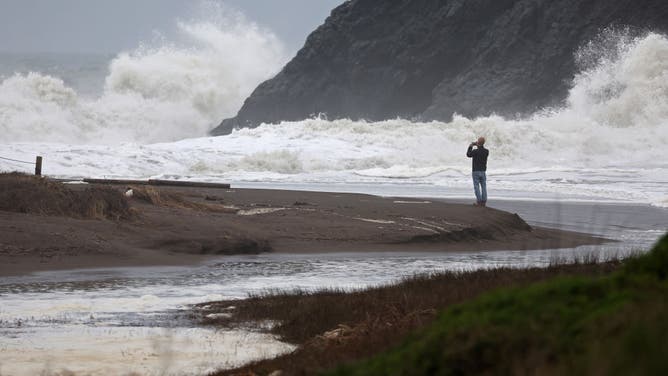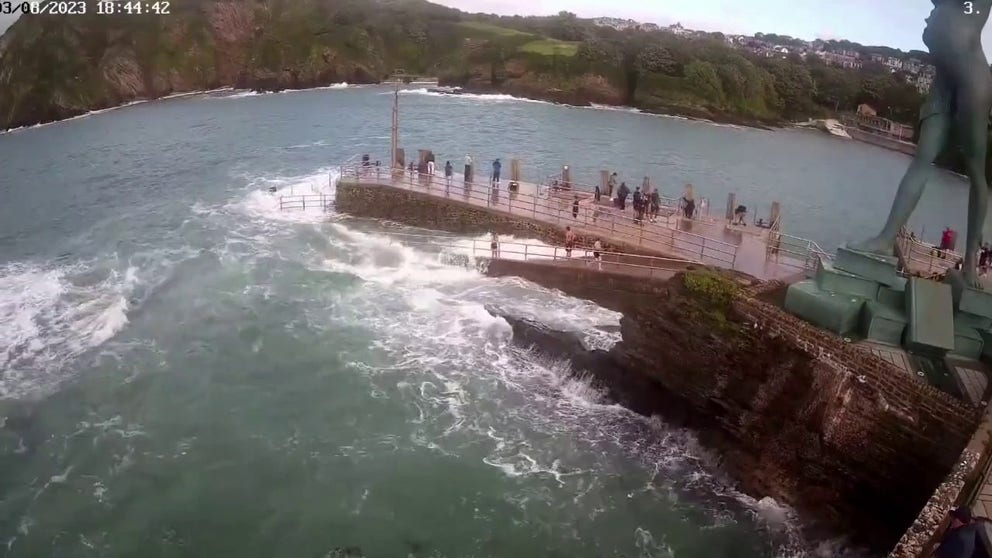What is a sneaker wave?
Coastlines from Northern California through Washington and southwest Canada are susceptible to sneaker waves because of the steep slopes. Rogue waves are typically experienced at sea, while sneaker waves are defined due to their impacts along the coast.
Watch: Video captures moment large wave sweeps child out to sea in England
A dramatic video recorded in England shows a large wave sweeping a child out to sea, and then a group of people working together to make a dramatic rescue.
A hazardous wave that can surpass normal surf activity and become deadly and destructive is known as a sneaker wave.
While there is no scientific definition, NOAA says a sneaker wave is a rush of water that surges up the coast further than expected.
The results can surprise beachgoers and become deadly by catching people off guard. Some of the waves can surge more than 150 feet up the beach and dislodge large objects, including logs.
Rocky coastlines, especially in Northern California, Oregon, Washington and Canada, are known to experience these waves without warning because of steep slopes.
NOAA says the power of the water can dislodge large boulders and trees, making the waves dangerous with debris.
WHAT IS A ROGUE WAVE? THESE MONSTERS OF THE OCEAN ARE MORE COMMON THAN YOU THINK

SAUSALITO, CALIFORNIA - JANUARY 07: A man takes a picture of rough surf as a storm comes in Rodeo Beach on January 07, 2023 in Sausalito, California. The San Francisco Bay Area continues to get drenched by powerful atmospheric river events that have brought high winds and flooding rains. The storms have toppled trees, flooded roads and cut power to tens of thousands. Storms are lined up over the Pacific Ocean and are expected to bring more rain and wind through next week.
(Photo by Justin Sullivan/Getty Images / Getty Images)
The combination of the waves and cool water temperatures makes the situation even more perilous, as anyone who unexpectedly ends up in the ocean can suffer hypothermia within minutes.
There is little a beachgoer can do to spot the arrival of a sneaker wave other than to constantly monitor changes in the surf.
Meteorologists say the waves are more common when storm systems produce a long period swell of at least 15 seconds.
WHAT HAPPENS UNDERWATER DURING A HURRICANE?
National Weather Service offices do not have designated alerts that can be issued when sneaker waves are expected; however, meteorologists do include information about the rough surf in beach hazard statements.
Beach hazard statements can include numerous coastal communities and are geared towards alerting local agencies, beachgoers and marine interests about the potential for dangerous conditions.
The NWS office in Eureka, California, recently issued a beach hazard statement that focused on the threat of sneaker waves.

The National Weather Service Office in in Eureka, California, warning about sneaker waves
(NOAA)
The statement read, "Large, unexpected waves can sweep across the beach without warning, sweeping people into the sea from rocks, jetties and beaches. These sneaker waves can also move large objects such as logs, crushing anyone caught underneath."
Under the suggested preparedness section, the statement went on to read: "Don't be fooled by an ocean that looks calm. There can be 30 minutes of small waves before a sneaker wave strikes. Avoid rocks and jetties. Avoid steep beaches. Stay much farther back from the water and never turn your back on the ocean."
According to NOAA, sneaker waves kill more people along the West Coast than all other weather hazards.
